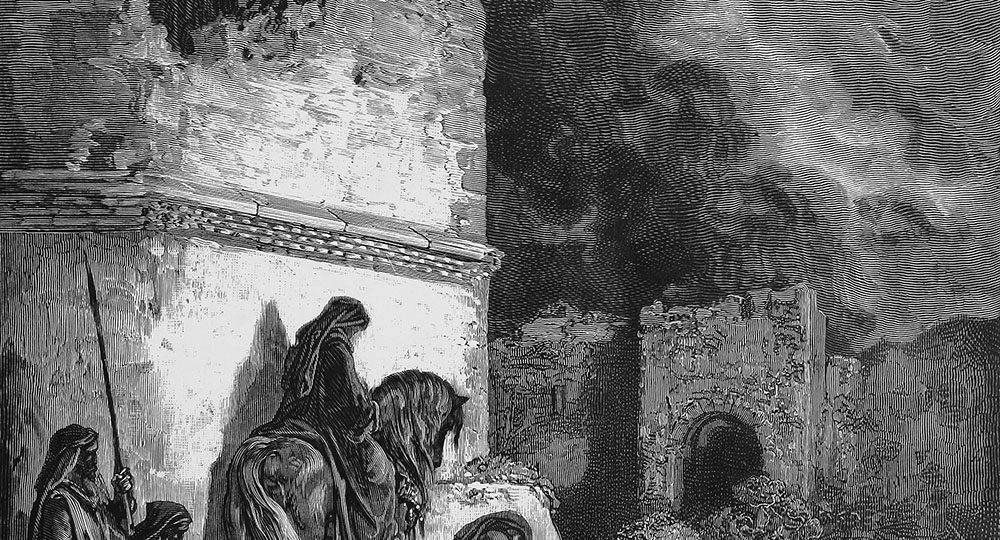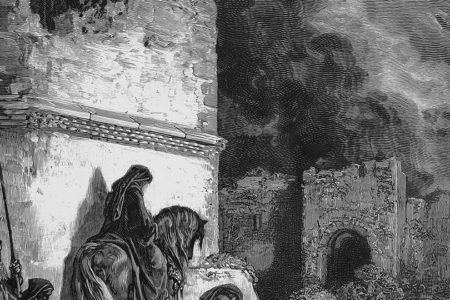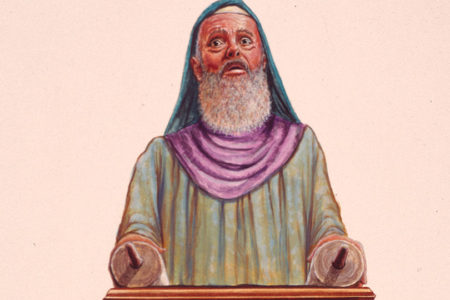The Gates Of Jerusalem in Nehemiah’s Day
When the Jewish people returned to their homeland after the Babylonian Captivity, Jerusalem lay in ruins. The Temple, the city walls, and the gates had been destroyed as a result of the three invasions of Nebuchadnezzar and his forces in 606 BC, 597 BC, and 586 BC. Much work needed to be done, and Zerubbabel, Ezra, and Nehemiah each led groups of the returned remnant in rebuilding the city of Jerusalem.
Nehemiah chapter 3 describes the building of the walls and gates of the city, giving the names of the individuals and families who performed the work and the portion of the wall or gates on which they were employed.
This article describes the rebuilding of the ten gates in the walls surrounding Jerusalem. The dictionary defines a gate as a movable structure controlling entrance or exit through an opening in a fence or wall or any means of entrance. Thus, restoring the gates was a necessary element in rebuilding the walls and securing the city.
Nehemiah’s task was enormous, especially under the adverse conditions he encountered. The job required an unusual organizational structure-a team effort. He therefore devised a plan to delegate the work, as described in chapter 3. To accomplish the task, Nehemiah assigned specific work places to individuals and families, as evidenced by the constant repetition of the phrases “next to him,” “next to them,” and “next to that” throughout this chapter.
Assignments were made in accordance with Nehemiah’s master plan. People were assigned to work on sections of the wall or gates near their homes, which provided the motivation needed to complete the work. It also avoided wasting time traveling to other parts of the city and assured the workers that they would be near their homes to protect their families in the event of an attack. Each family was to use all of its available talent, thus making it a household project (vv. 21, 23–24, 26, 28–30). In addition to local residents, many people who lived outside of Jerusalem were assigned to work on sections of the wall where homes were sparse (vv. 2, 5, 7, 27).
Some of the work assignments were given according to vocations. For instance, the high priest and other priests were assigned to rebuild the Sheep Gate (v. 1), which was important to the priests because animals were brought through that gate to the Temple for sacrificial offerings. Additional work in other areas was also done by the priests (vv. 22, 28). Other vocations included goldsmiths (v. 8), perfume makers (v. 8), rulers of districts and half districts (vv. 9–12, 14–19), Levites (v. 17), and merchants (vv. 31–32). Even the daughters of one ruler were involved in the difficult work (v. 12).
Background information for chapter 3 is given in verses 2:9 to 20. Nehemiah challenged the people to “rise up and build” (2:17–18) in the midst of ridicule and opposition (2:19).
Ten gates are mentioned in chapter 3, proceeding counterclockwise from the north wall of the Temple. The circumference of the walls was approximately two and one-half miles, encompassing approximately 220 acres. In studying the names and associations of these ten gates, we also encounter reflections of spiritual applications for our lives today.
The Sheep Gate, Fish Gate, and Old Gate were located in the northern section of the wall.
The Sheep Gate (vv. 1, 32) was located on the northeast corner of the wall. It was so named because sheep were led through it to the Temple. It was near the market where sheep were sold and close to the Sheep Pool where the Temple sacrifices were washed. The Sheep Gate was also near the Pool of Bethesda (Jn. 5:2). Between the Sheep Gate and the Fish Gate were the Tower of Hammeah (hundred) and the Tower of Hananel (12:39). The Tower of Hananel is also mentioned in Jeremiah 31:38 and Zechariah 14:10 as the northernmost part of the city.
The Sheep Gate is a reminder of the cross. Christ was “the Lamb of God, who taketh away the sin of the world” (Jn. 1:29). Mankind is described as wayward sheep (Isa. 53:6) who need a shepherd to lead them into God’s eternal sheepfold (heaven). Jesus is the door through which sinners can enter the sheepfold and be redeemed (Jn. 10:1–9). Christians are “bought with a price” (1 Cor. 6:20), the blood of God’s Lamb, Jesus Christ.
In the days of the First Temple, the Fish Gate (v. 3) was one of Jerusalem’s main entrances (2 Chr. 33:14). It led out to the main road north from Jerusalem that descended to the coastal plain through Beth-Horon. The consensus of opinion locates it close to the site of the present-day Damascus Gate. It was called the Fish Gate because merchants brought fish from Tyre or the Sea of Galilee through it to the fish market (13:16).
The Fish Gate can be applied to soul winning. We are to become “fishers of men” (Mt. 4:19) in response to Jesus’ call to His disciples. The Scriptures state that “he that winneth souls is wise” (Prov. 11:30) and “He that goeth forth and weepeth, bearing precious seed, shall doubtless come again with rejoicing, bringing his sheaves [souls] with him” (Ps. 126:6). Every believer should heed God’s great commission (Mt. 28:19–20) and share the message of salvation, so that souls will be saved and we will shine “as the stars forever and ever” (Dan. 12:3).
The Old Gate (v. 6) was situated in the northwest corner and is identified with the Corner Gate of 2 Kings 14:13 and Jeremiah 31:38. Opinions differ concerning the use of the term Old Gate, but some believe this gate was so named, because it was the main entrance into the old city of Salem (Jerusalem) on the north side.
The Old Gate reminds us of the old nature of Christians. It contrasts God’s ways and will with our old lifestyle before we began to walk with Him (Jer. 6:16). We are to put off the tenets of the old nature and walk in the newness of Christ’s life (Col. 3:5–17), so that sin has no dominion over our daily lives (Rom. 6:6–14).
The Valley Gate (v. 13) was located in the western section of the wall. It was the place where Nehemiah began and ended his nighttime inspection of the walls (2:13–15). It led into the lowly Tyropoeon Valley and is in the area of the present-day Jaffa Gate.
The Valley Gate represents humility and our willingness to occupy a lowly place in the Lord’s service. Christ set the example by humbling Himself (Phil. 2:8). Peter commissioned us to “Humble [ourselves] … that he may exalt [us] in due time” (1 Pet. 5:6). Jesus Himself challenged believers to positions of humble servitude, stating, “whosoever exalteth himself shall be abased; and he that humbleth himself shall be exalted” (Lk. 14:11).
The Dung Gate was located in the southern section of the wall (v. 14). It was so named because it led to the Hinnom Valley, south of Jerusalem, where refuse was dumped.
The Dung Gate suggests the need for constant cleansing. The filth of the city was carried out through this gate, reminding us of the constant need to be cleansed from the sinfulness of the flesh and spirit. The nation of Israel was challenged to depart from Babylon: “go out from there, touch no unclean thing; go out of the midst of her; be ye clean, that bear the vessels of the LORD” (Isa. 52:11). Today Christians are to “cleanse [themselves] from all filthiness of the flesh and spirit, perfecting holiness in the fear of God” (2 Cor. 7:1). In other words, we are to be holy in all areas of life (Lev. 11:44; 1 Pet. 1:15–16).
The Fountain Gate and Water Gate were located in the southeastern part of the wall.
The Fountain Gate (v. 15) was northeast of the Dung Gate, near the Pool of Siloam by “the king’s garden” (2 Ki. 25:4) and led into the Kidron Valley. It derived its name from the location where the Siloam Tunnel emerged from the ground with water from the Gihon Spring, the fountain par excellence of Jerusalem.
The Fountain Gate alludes to the Holy Spirit. During the Feast of Tabernacles Jesus stated, “If any man thirst, let him come unto me, and drink. He that believeth on me, as the scripture hath said, out of his heart shall flow rivers of living water” (Jn. 7:37–38). In obedience to Christ’s invitation, we are to be filled (controlled) by the Holy Spirit (Eph. 5:18).
The Water Gate (v. 26) was part of the palace-Temple complex rather than in the wall. It was so named because it led to the city’s main source of water, the Gihon Spring. It apparently encompassed a large area, for the reading of the law took place there (8:1, 3, 16).
The Water Gate can be related to the Word of God. Jesus compared Himself to water, a type of God’s Word, when He spoke to the Samaritan woman at Jacob’s well (Jn. 4:5–14). We are challenged to be diligent students of the Scripture in order to rightly divide the word of truth (2 Tim. 2:15). God’s Word will thoroughly develop spiritual maturity in the lives of those who read it (2 Tim. 3:16–17).
The Horse Gate, East Gate, and Muster or Inspection Gate were located in the northeastern section of the wall.
The Horse Gate (v. 28) was on the east side of the Temple overlooking the Kidron Valley. It was the gate through which horses entered and exited the palace area, and the horse stables were probably located near it.
The Horse Gate is a reminder of the believers’ warfare because the horse is a symbol of war. This gate reminds us of our need to be good soldiers of Jesus Christ (2 Tim. 2:3) and to be fully equipped to fight the good fight of faith (Eph. 6:10–18; 2 Tim. 4:7).
The East Gate (v. 29) was directly east of the Temple area, located below the present-day Golden Gate. The people entered the Temple through this gate, on their way to worship the Lord and present their offerings and sacrifices to Him.
The East Gate suggests the return of Christ, which will take place in two stages. He will return first for His own (Jn. 14:1–3) and second with His own (1 Th. 3:13). He will appear as “the bright and morning star” to the church (Rev. 22:16) and as “the Sun of righteousness” to Israel (Mal. 4:2).
The Muster or Inspection Gate (v. 31) was located in the northernmost section of the wall. The word for inspection is found in only three other passages: 2 Samuel 24:9 and 1 Chronicles 21:5, where it means numbering or mustering, and Ezekiel 43:21, where it means the appointed place for the sin offering to be burned. The elders sat at this gate judging and rendering decisions in matters brought before them.
The Muster or Inspection Gate can pertain to the Judgment Seat of Christ. After the Rapture of the church, every believer will stand before the Judgment Seat of Christ to “give an account of himself to God” (Rom. 14:10–12). Each person will be judged “according to that he hath done, whether it be good or bad” (2 Cor. 5:10) and will be rewarded “according to his own labor” (1 Cor. 3:8). All our works will be tried by fire to determine their value for Christ (1 Cor. 3:13–15).
When the repairs to the Inspection Gate and the section of the wall to the corner were completed, the work had come full circle back to the Sheep Gate (v. 32), which, as stated above, represents the cross. God does not want us to forget that we were once and for all time purged from our old sins and are now sinners saved by grace (2 Pet. 1:9).
So intense were the laborers in completing the task of rebuilding the walls and gates that the job was completed in 52 days (6:15). “The people had a mind to work” (4:6) backed by determination to see the project completed. When the task was done, Israel’s enemies “perceived that this work was wrought by [Israel’s] God” (6:16).
With the exception of the nobles of Tekoa (3:5), everyone participated-from the high priest to goldsmiths, perfume makers, rulers, Levites, merchants, and women-and some did more than their share (v. 27). This is an inspiring example of what can be accomplished when God’s people work together under dynamic leadership. As in the time of Nehemiah and his faithful laborers, much work remains to be done today. Spiritual leaders are needed to inspire God’s people to “arise and build” (2:20) for His honor and glory. The church needs both dedicated leaders and workers who have “a mind to work” for the Lord until He returns for His own.









Here it is in the year 2023 and the Lord quickened to me to read slowly through the Bible again this year. This time Nehemiah 3 was highlighteed by The Holy Spirit. It is 5 AM when again I was drawn to more research and immediately this article came up. I saw Jesus plan partially on the first 2 gates, but WOW WOW WOW on the rest.
Dear sir, in the name of our lord and savior Jesus Christ, last day I was looking some maps concerning gates of old Jerusalem city from a bible dictionary after reading Nehemiah 1 to 3 chapters. So, there arose a zeal in me to know about gates, their names and their importance. So, today I put a question concerning the gates in Google search for which I got a wonderful explanation beyond my expectation which I never guessed earlier to this. It is really a heart touching explanation. I thank God for providing me with a satisfied answer which gave me immense joy and satisfaction. Thank you
I thank God for the explanation of his words and for helping me to locate the gates of Jerusalem during Nehemiah’s day. God bless your work. Continue the good work in Jesus’ name. Amen.
I did know that there was 10 gates around the city Jerusalem some time you read the bible and you miss things this was one of those things that I miss.
I too can say it was rather uplifting and inspiring. My spiritual eye sight has been opened on Nehemiah chapter 3, just what I wanted.
Thank you so very much for sharing your knowledge.
Jesus bless you!
Praise the Lord . Biblical studies and interpretation of God’s word is truly very nice. So many truth about the gates of Jerusalem..
I used to read Israel my glory 27 years ago and I enjoyed it much. In this issue also I got great ideas about the fates of Jerusalem in an excellent way. Thank you.
Thank you so much for studying and giving insight information about the gates. Exactly what i have been looking for. God bless you!
Isn’t Gods word ever fresh….so multi dimensional. Everything was written so intentionally. May we have the eyes to not only see Jesus, through the word but to encounter Him so this word becomes flesh….God greatly enrich you dear Labourer in our Lord’s Vineyard.
Heart warming knowledge ,it makes me feel power full and enlightened. Great work.
Very insightful teaching. The explanation of purpose of each gate and link with the new testament. Great revelation.
I wanted to find out more about Chapter 3 in Nehemiah. I had no idea what a wealth of information there was in this chapter. Thank you so much!
Thank you for sharing the knowledge and revelation. Manifolds of more revelations upon you.
This was worthy to read to understand the significance of the gates to the now christian, I am blessed of it. Thank you and shalom.
Thank you very much for this article. It helped me have a better understanding about the book of Nehemiah. The Bible Study group I am in, studied the book of Nehemiah. My Pastor’s wife told me to go deep instead of just reading it. Well this took me deep and I appreciate it. My eyes have been enlightened. The Bible has come to life for me. God BLESS you.
excellent, i am very happy to understand the meaning of the gates. god bless you.
Love this commentary. Very insightful and appreciated. God’s Blessings to you
This was awesome, the Lord kept telling me to research the meaning of the gates and how it relates to our days now and also in standing in watch and intercession.
S. Charles: I thought I was the only one who saw significance in the city gates.
I was only researching for the ancient ruins of Walled Jerusalem and I was led to your website and was enlightened more with the spiritual meaning of each gate. Thanks God forever.
This was such a pleasure to read. Thank you for sharing and the in-depth details of the gates and their meanings. This was exactly what I was hoping to find. Like Hidden Treasure!
Thank you for your enlightening article.
A pictorial map would be of great help.
I appreciate your work and organizing the bridge of meaning between the gatesm Jesus and our lives. You are saluted. We shall grow in knowledge.
Awesome article.
I was empowered.